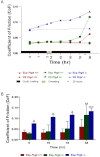Cyclic loading increases friction and changes cartilage surface integrity in lubricin-mutant mouse knees
- PMID: 21905020
- PMCID: PMC3252402
- DOI: 10.1002/art.33337
Cyclic loading increases friction and changes cartilage surface integrity in lubricin-mutant mouse knees
Abstract
Objective: To investigate the effects of lubricin gene dosage and cyclic loading on whole joint coefficient of friction and articular cartilage surface integrity in mouse knee joints.
Methods: Joints from mice with 2 (Prg4(+/+)), 1 (Prg4(+/-)), or no (Prg4(-/-)) functioning lubricin alleles were subjected to 26 hours of cyclic loading using a custom-built pendulum. Coefficient of friction values were measured at multiple time points. Contralateral control joints were left unloaded. Following testing, joints were examined for histologic evidence of damage and cell viability.
Results: At baseline, the coefficient of friction values in Prg4(-/-) mice were significantly higher than those in Prg4(+/+) and Prg4(+/-) mice (P < 0.001). Cyclic loading continuously increased the coefficient of friction in Prg4(-/-) mouse joints. In contrast, Prg4(+/-) and Prg4(+/+) mouse joints had no coefficient of friction increases during the first 4 hours of loading. After 26 hours of loading, joints from all genotypes had increased coefficient of friction values compared to baseline and unloaded controls. Significantly greater increases occurred in Prg4(-/-) and Prg4(+/-) mouse joints compared to Prg4(+/+) mouse joints. The coefficient of friction values were not significantly associated with histologic evidence of damage or loss of cell viability.
Conclusion: Our findings indicate that mice lacking lubricin have increased baseline coefficient of friction values and are not protected against further increases caused by loading. Prg4(+/-) mice are indistinguishable from Prg4(+/+) mice at baseline, but have significantly greater coefficient of friction values following 26 hours of loading. Lubricin dosage affects joint properties during loading, and may have clinical implications in patients for whom injury or illness alters lubricin abundance.
Copyright © 2012 by the American College of Rheumatology.
Figures





Similar articles
-
Lubricin restoration in a mouse model of congenital deficiency.Arthritis Rheumatol. 2015 Nov;67(11):3070-81. doi: 10.1002/art.39276. Arthritis Rheumatol. 2015. PMID: 26216721 Free PMC article.
-
Superficial zone cellularity is deficient in mice lacking lubricin: a stereoscopic analysis.Arthritis Res Ther. 2016 Mar 14;18:64. doi: 10.1186/s13075-016-0967-4. Arthritis Res Ther. 2016. PMID: 26975998 Free PMC article.
-
Intra-Articular Adeno-Associated Virus-Mediated Proteoglycan 4 Gene Therapy for Preventing Posttraumatic Osteoarthritis.Hum Gene Ther. 2022 May;33(9-10):529-540. doi: 10.1089/hum.2021.177. Epub 2022 Jan 7. Hum Gene Ther. 2022. PMID: 34610749 Free PMC article.
-
The biology of lubricin: near frictionless joint motion.Matrix Biol. 2014 Oct;39:17-24. doi: 10.1016/j.matbio.2014.08.008. Epub 2014 Aug 27. Matrix Biol. 2014. PMID: 25172828 Review.
-
Prg4-Expressing Chondroprogenitor Cells in the Superficial Zone of Articular Cartilage.Int J Mol Sci. 2024 May 21;25(11):5605. doi: 10.3390/ijms25115605. Int J Mol Sci. 2024. PMID: 38891793 Free PMC article. Review.
Cited by
-
Cartilage Derived from Bone Marrow Mesenchymal Stem Cells Expresses Lubricin In Vitro and In Vivo.PLoS One. 2016 Feb 11;11(2):e0148777. doi: 10.1371/journal.pone.0148777. eCollection 2016. PLoS One. 2016. PMID: 26867127 Free PMC article.
-
Contrast-enhanced CT using a cationic contrast agent enables non-destructive assessment of the biochemical and biomechanical properties of mouse tibial plateau cartilage.J Orthop Res. 2016 Jul;34(7):1130-8. doi: 10.1002/jor.23141. Epub 2016 Jan 6. J Orthop Res. 2016. PMID: 26697956 Free PMC article.
-
Preventing friction-induced chondrocyte apoptosis: comparison of human synovial fluid and hylan G-F 20.J Rheumatol. 2012 Jul;39(7):1473-80. doi: 10.3899/jrheum.111427. Epub 2012 Jun 1. J Rheumatol. 2012. PMID: 22660808 Free PMC article.
-
How Do Cartilage Lubrication Mechanisms Fail in Osteoarthritis? A Comprehensive Review.Bioengineering (Basel). 2024 May 24;11(6):541. doi: 10.3390/bioengineering11060541. Bioengineering (Basel). 2024. PMID: 38927777 Free PMC article. Review.
-
Effects of stress deprivation on lubricin synthesis and gliding of flexor tendons in a canine model in vivo.J Bone Joint Surg Am. 2013 Feb 6;95(3):273-8. doi: 10.2106/JBJS.K.01522. J Bone Joint Surg Am. 2013. PMID: 23389791 Free PMC article.
References
-
- Bao JP, Chen WP, Wu LD. Lubricin: a novel potential biotherapeutic approaches for the treatment of osteoarthritis. Mol Biol Rep. 2011;38:2879–85. - PubMed
-
- Elsaid KA, Jay GD, Warman ML, Rhee DK, Chichester CO. Association of articular cartilage degradation and loss of boundary- lubricating ability of synovial fluid following injury and inflammatory arthritis. Arthritis Rheum. 2005;52:1746–55. - PubMed
Publication types
MeSH terms
Substances
Grants and funding
LinkOut - more resources
Full Text Sources
Miscellaneous

